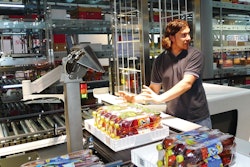Much like the complexity of some chemical compounds, so is the supply and demand chain for the chemical industry. The chemical supply and demand chain requires extra vigilance to achieve success due to a host of factors: access to raw materials, price volatility, supply chain disruptions, global competition, the use of hazardous materials in some cases (and their related regulations and safety precautions) and more.
Another is timing. “As a leading indicator of future economic activity, the chemical industry typically experiences the impacts of changes to economic activity before other industries, and as a result, tends to be in reactionary mode to economic changes more than downstream industries, “according to Brian Murphy, business development director, consumer industry group, and Paul Kohlhoff, senior program manager, Menlo Logistics. “The other challenge is the lead time to throttle up or down on production is longer than manufacturing, so syncing inventories to demand levels is also more difficult.”
Uncertainty Tugs at the Supply and Demand Chain
“Chemical manufacturing depends on raw materials, which are subject to environmental, political and economic influences,” muses Warren Hoppmeyer, senior director, chemical solutions, Transplace. Chemicals are part of an exceedingly global market, so companies must consider the changing landscape of each country with which they deal—whether it be environmental regulation, the political climate or currency—and take each independently into account when making decisions.
The chemical market’s largest challenge is overall uncertainty. There are many potential events that cannot be anticipated. Hoppmeyer indicates that there are weather disruptions, the wide swings or unanticipated regional raw material cost volatility affecting production costs, governmental regulations affecting manufacturing and transportation, transportation equipment and driver shortages, and so on.
Hoppmeyer also attributes some uncertainty to “unplanned production issues on both the raw material and manufacturing side. There’s a lot of equipment and moving parts involved, as well as chemical reactions, so there’s always the possibility of something arising that could force you to shut down. This could disrupt the supply chain by requiring a company to have to manufacture a product somewhere else or ship from another location, which may not be optimal or is more costly.”
Murphy and Kohlhoff agree that many challenges face the chemical industry, “In the specialty chemical supply chain, the challenges are often competing for the raw materials with competitors. If the product is regarded more as a commodity chemical where raw materials are typically readily available, the priority is in building a cost-effective, yet reliable and flexible supply chain that can flex up and down with demand, while also having product readily available.”
Overcoming Obstacles in the Chemical Supply and Demand Chain
To combat the uncertainty in the chemical supply chain, visibility and collaboration are key. Murphy and Kohlhoff suggest, “Consolidation of data sources from trading partners is the backbone of gaining visibility up and down the supply chain. Using fourth-party logistics providers (4PLs) to be the quarterback in instances that require multiple vendors and suppliers coming together helps to drive the project to completion and drive a continuous improvement mindset. It’s extremely difficult for producers to bring this concept to fruition due to the nuances of vendor systems, processes and ‘policies’ along the supply chain.
“With the goal of creating a visible and flexible supply chain that has layers built in to create redundancy and avoid risk, many chemical producers look to build an optimized solution from the customer back to the raw materials,” say Murphy and Kohlhoff. “The process of creating a value stream map that identifies all of the flows and nods that go into the current state is step one.
“After identifying current state from a people, process and infrastructure (physical and systematic) perspective, a producer, with the help from its 4PL, can look at specific areas where optimization makes sense and doesn’t take on additional risk. Reviewing each of these flows/supply chain areas, with the eyes to reduce any process that was absorbed from former requirement considerations, gets the producer to a more optimized state.”
Additionally, Murphy and Kohlhoff believe, “Utilization of ‘control tower’ concepts in which raw materials and material flow in the supply chain can be re-allocated or diverted provides a certain level of risk mitigation.”
Insulating the Supply and Demand Chain from Disruption
Companies can overcome supply challenges by not only maintaining close relationships with their product and service suppliers, but also drawing from a larger pool of suppliers. If something goes awry with a regular supplier, having a diversified list of manufacturers or service providers to choose from is a good business practice, and of course, should be outlined in a comprehensive contingency plan. “Establish long-term contacts with both raw goods manufacturers, as well as transportation carriers, to make sure you’re protected, and have assurance of continuity of supply and services,” Hoppmeyer says, and “establish long-term, strategic partnerships with your core carriers in order to lock in capacity and competitive rates.”
Murphy and Kohlhoff concur, “Identifying partnerships that have eyes for waste reduction becomes paramount. With certain factors and consequences fixed, if a producer can find partners that know how to develop a continuous improvement plan affecting the supply chain, then more flexibility can be created in logistics to offset some of the natural costs that come with this volatility.”
The long and short of is keep your customers close, but your suppliers even closer, so you know that you can deliver what your customer wants when they want it. In that vein, it’s advised that, according to Hoppmeyer, companies “conduct periodic contingency planning reviews and continuously improve processes. Conduct long- and short-term supply and demand reviews. Leverage technology and best practices to achieve effective and accurate shipment visibility.”
SIDEBAR: Smoothing Out the Supply Chain Map
Hoppmeyer suggests the following to overcome challenges in the chemical supply and demand chain:
- “The establishment of highly integrated production facilities that centralize the majority of the production of chemicals to a single site, which minimizes the movement and disruption within the supply chain.
- The capability to have alternative capacity through toll manufacturers. While generally used by manufacturers of highly specialized products that depend heavily on one supplier, having an alternative or two provides flexibility if they need to move products somewhere else due to a problem with a facility or are unable to get product there.
- Swap agreements with co-manufacturers. In the event of a production outage or long-term shutdown, swap agreements with other manufacturers give chemical companies an additional way to source needed materials.
- Joint ventures for key raw materials. This allows companies who have a vested interest in raw material or are co-producing a product to enter a partnership, and share some of the risk and ease some of the volatility that may exist.
- Partners who can maintain a broader access to providers. Leverage a service provider that has broader access to numbers of providers and carriers than any one individual supplier.
- Shipment visibility. By leveraging a transportation management system, chemical companies can improve visibility and optimize their transportation operations.
- Broadcasting uncovered shipments to approved carriers, which allows a shipper’s freight needs to be simultaneously broadcasted to all approved carriers, who can then offer capacity for each load based on rates already established or based on pre-set parameters.”




















